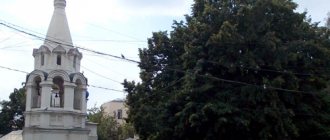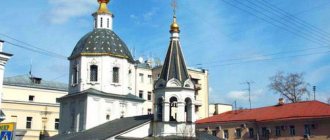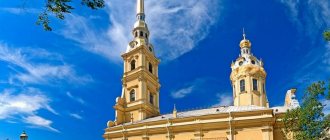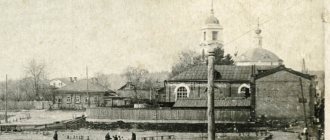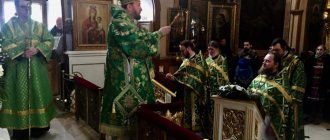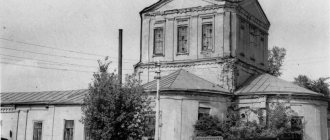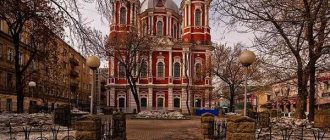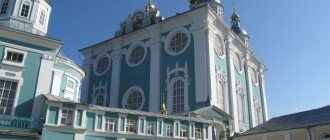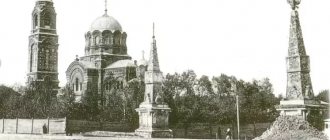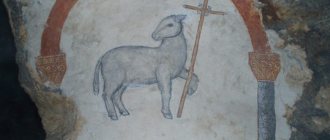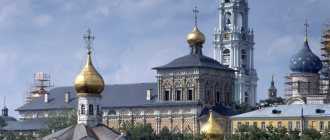In the capital, a large-scale restoration of the ensemble of the Vysoko-Petrovsky Monastery and the Great Ascension Church at the Nikitsky Gate has been completed. The results of the work were inspected by Sergei Sobyanin, Patriarch of Moscow and All Rus' Kirill and Plenipotentiary Representative of the President of Russia in the Central Federal District Igor Shchegolev.
“A huge range of works on the restoration of monuments is being carried out in Moscow. This is an astronomical figure; by this year, more than a thousand monuments have been put in order. Moreover, it is noteworthy that less than half was restored by the city, and the rest came from donations from philanthropists and various departments that put in order the objects that they own,” noted Sergei Sobyanin.
Patriarch Kirill of Moscow and All Rus' also noted the large amount of restoration work that is being carried out in the capital, in particular on the oldest monuments and Orthodox churches.
“It is wonderful that at the beginning of the 21st century such large-scale restoration work is being carried out. In addition to the fact that in general Moscow is becoming prettier: the streets are changing, transport is changing, it is very important that the oldest and most valuable objects are being restored, real scientific restoration is underway,” he said.
Sergei Sobyanin congratulated Patriarch Kirill on his belated birthday, wishing him happiness, health and success on behalf of Muscovites.
“Through your efforts, such churches are returned to the city - architectural monuments, this is a gift to all Muscovites and to you, too, for your efforts,” added the Moscow Mayor.
New life of the Great Ascension Church at the Nikitsky Gate
The Great Ascension Temple is a cultural heritage site of federal significance. Its total area is 2.3 thousand square meters.
In 2017–2018, the temple underwent a major restoration. It became the final stage in the revival of the Moscow shrine.
Over the course of two years, specialists restored the paintings on the walls and vaults of two chapels, the central altar and the domed part of the temple. Also, on the walls and vaults of the three altars and in the under-dome part, a layer of plaster was strengthened and soot was removed, and the stucco and artificial marble decorations were renewed. Workers repaired the roof, and now the interior of the church is not in danger of flooding.
“Now the wall paintings have been completely restored. It looks the way it looked in the 19th century,” said Sergei Filatov, deputy director for scientific and restoration work at the State Research Institute of Restoration, author of the painting restoration project.
The first mention of the wooden Church of the Ascension of the Lord in Storozhi dates back to 1619 .
At the end of the 17th century, not far from it was located a country palace and the courtyard of the second wife of Tsar Alexei Mikhailovich Romanov - Natalya Kirillovna Naryshkina, the mother of the future Emperor Peter I. It is assumed that in 1670, on the site of a burnt wooden building, she began to build a new, stone one, which was completed in the 1680s.
In the 18th century, in the parish of the Church of the Ascension there was the house of Alexander Vasilyevich Potemkin, the father of Prince Grigory Potemkin-Tauride.
In the 1780s, Grigory Potemkin decided to rebuild the Ascension Church and erect a “new, magnificent temple” at least 60 meters high on the site that belonged to him. It was supposed to be called the church of the Life Guards Regiment of the Preobrazhensky Regiment, since the regimental yard was located nearby.
The first architect of the temple was Vasily Bazhenov . After the death of Prince Potemkin in 1791, Major General Nikolai Vysotsky took over the construction, who attracted another famous architect of the time, Matvey Kazakov.
Construction of the new Ascension Church began in the spring of 1798. According to the project, the building was to become a pompous cathedral with a high bell tower, a gallery and sculptures along the facade.
However, construction progressed slowly. By 1812, only the refectory was built and decorated. The building of the temple itself was not even half built - only the foundation and plinth were ready, bases for the columns were installed.
And in the fire of 1812, the building completely burned down along with the drawings of Matvey Kazakov.
It was decided to build the church again in the same place. The refectory was finished quite quickly, and already in 1816 church services began to be held in it.
The surviving drawings bear the signatures of the architects Fyodor Shestakov, Nikolai Kozlovsky, Afanasy Grigoriev. The Russian architect Osip Bove also had a hand in the project, who enlivened the austere appearance of the building with Ionic porticoes with columns.
For various reasons, the construction of the temple dragged on for several decades. The end was reached only in 1840. By this time, not only the construction work had been completed, but also the painting of the temple, carried out by a team of Italian artists. The iconostases were made according to the designs of the architect Mikhail Bykovsky. The old Church of the Ascension was dismantled, but the bell tower, which stood on the site of the current park, near the monument to the writer Alexei Tolstoy, was not demolished and existed until the 1930s.
Many significant events in the history of Moscow took place in the Great Ascension Church. Perhaps the most striking of them is the wedding of Alexander Pushkin and Natalya Goncharova on February 18, 1831 in an unfinished building. Many years later, in 1999, on the 200th anniversary of the poet’s birth, a rotunda fountain “Natalia and Alexander” was installed near the temple in memory of this event.
In 1920, the wedding of Fyodor Chaliapin’s daughter took place here, and the artist himself performed holiday chants here.
Guidebooks to Moscow in the 19th century invariably indicated that the Church of the Ascension at the Nikitsky Gate was especially popular among the Moscow intelligentsia who lived in the city center. Gradually, a tradition was established to perform funeral services in this church for illustrious representatives of the Moscow theater world. In particular, Mikhail Shchepkin and Maria Ermolova .
This building witnessed the events of 1917. According to eyewitnesses, on Nikitsky Gate Square, right next to the walls of the temple, there were particularly heavy battles between the cadets defending the Provisional Government and the Bolsheviks. On November 13, 1917, a funeral service for cadets and officers who died during the October battles was held in the church.
In 1925, Patriarch Tikhon served his last liturgy here.
And the temple was finally closed in the fall of 1931. The silver crowns with which Alexander Pushkin and Natalya Goncharova were crowned were transferred to the State Armory Chamber. All other decorations of the temple were destroyed. The paintings on the vaults were destroyed or covered over.
In 1937, the 17th-century tented bell tower was demolished and a park was laid out in its place. The temple itself was partially rebuilt: a second floor was built, new windows were punched in the walls, and the pediments above the columns were demolished. At one time it housed a garage, and a gate was punched into the wall near the main altar to allow cars to enter.
In the 1960s, the laboratory for the study of high-voltage gas discharges and lightning protection of the Energy Institute named after G.M. moved to the temple. Krzhizhanovsky, who left the temple building only in 1987.
But even then the temple was not handed over to the believers immediately; for some time they were going to open a cultural center with a concert hall here. Only in 1990, at the request of Muscovites, the temple was returned to the Russian Orthodox Church, and groups of volunteers began to restore it.
On September 23, 1990, the rite of minor consecration of the church was performed, marking the beginning of daily services.
On May 20, 1999, on the feast of the Ascension of the Lord, the rite of great consecration was performed by Patriarch Alexy II.
In 2002–2004, a new, 61-meter bell tower was built on the discovered foundation of the bell tower. Its project was developed based on the drawings of the project by Fyodor Shestakov. Also in the 2000s, the facades of the temple were restored.
In 2012, work was carried out to install a ramp and stairs on the side of Malaya Nikitskaya Street, the brickwork of the vaults and walls of the refectory, as well as seven fence posts, were strengthened. And in 2015, the Moscow Government carried out the improvement of Bolshaya and Malaya Nikitskaya streets.
Restoration of the ensemble of the Vysoko-Petrovsky Monastery
In Moscow, the next stage of restoration of the churches of the Vysoko-Petrovsky Monastery, an architectural ensemble located on Petrovka Street, has almost been completed. It is also a federal cultural heritage site.
“It is important to restore it completely so that it appears in all its glory and in its historical form, this is very, very important. The first such work has been completed today. I don't think we will stop. We will continue with your blessing,” said Sergei Sobyanin, noting that the Vysoko-Petrovsky Monastery occupies an important place in the history of the capital.
It consists of 12 buildings. In 2016–2018, restoration work was carried out on four of them.
The bell tower with the gate church is one of the architectural dominants of Petrovka Street. In 2016–2017, restoration of the facades, architectural stucco decoration, floor coverings of the upper tiers, walkways and interiors, and inter-tier staircases was carried out here.
The head was repaired (the gilded surfaces were washed). The brickwork of the walls, vaults, passage arch and stylobate was strengthened. The drainage system has been installed. The white stone plinth and roof have been restored. The installation of a white stone covering of the walkway with the recreation of water cannons and pinnacles was completed, as well as the installation of a blind area, window and door fillings, a stained glass block, white stone and wooden floors.
The Church of Peter the Metropolitan is one of the oldest churches in Moscow, built according to the design of the Italian architect Aleviz Fryazin (Novy).
In 2017–2018, work was carried out to restore the roof and facades of the church with strengthening the brickwork, installing white stone floors and blind areas, restoring the foundation, porch steps, and painting.
In 2021, work was carried out on the restoration of the gateway church of Pachomius : its facades, white stone walls (stylobate), plinth, decoration and porch, fencing of the cemetery, interiors, as well as the installation of floors and drainage systems, the window and door fillings were recreated, the roof was repaired and restored .
Work is currently underway in the Sergievskaya refectory . Here the facades of the quadrangle and apse (including white stone decor), the roof structures of the quadrangle, domes, and so on are restored. Completion of work is scheduled for 2021.
The work was financed within the framework of the Moscow Government's subsidy program for religious organizations for the restoration of architectural monuments.
Vysoko-Petrovsky Monastery is one of the oldest in the capital. Its foundation is associated with the name of Metropolitan Peter of Kyiv and All Rus', who transferred the metropolitan see from Vladimir to Moscow.
By the way, Petrovka Street and Petrovsky Gate in the wall of the White City got their names from the monastery.
The builders and benefactors of the monastery were Prince Ivan Kalita, Grand Dukes Dmitry Donskoy and Vasily III, Tsar Alexei Mikhailovich, Peter I and his mother Natalya Kirillovna Naryshkina, St. Philaret of Moscow.
In 2015, the 700th anniversary of the monastery . And the first stone church in the name of the saint and wonderworker Peter the Metropolitan appeared in the ensemble at the beginning of the 16th century. It was built on the site of a wooden temple of the same name according to the design of the Italian architect Aleviz Fryazin (Novy).
In 1611, the monastery served as an outpost of the Kremlin defense for the first people's militia.
The main part of the modern architectural complex of the Vysoko-Petrovsky Monastery was built in the 17th–18th centuries. From 1684 to 1704, around the Church of Metropolitan Peter in the central (church) courtyard, an expressive ensemble of stylistically homogeneous monumental stone buildings developed, including the Bogolyubsky Cathedral with the Naryshkin family tomb, the refectory church of St. Sergius of Radonezh, the holy gate with the gate church of the Intercession of the Virgin and a high-tiered belfry. Adjacent to them, on the territory of the central courtyard, an ancient necropolis and several old stone and wooden buildings were preserved.
The major reconstruction of the monastery was carried out on the initiative of Tsarina Natalya Kirillovna, née Naryshkina, with the personal participation of Peter I and according to his decrees. In the 1680s–1690s, on the western border of the southern courtyard along the line of Petrovskaya Street, an extended and elegantly decorated two-story building of the Naryshkin Chambers was erected. New elements appeared in the ensemble of the monastery in the middle of the 18th century. This is a residential complex with a two-story abbot's house, and two new churches: the church in the name of the Tolga Icon of the Mother of God and the Church of St. Pachomius above the Rear Gate.
In the 1830s–1840s, most of the non-church premises of the monastery ensemble were rented out . The Naryshkin Chambers housed a religious school, a bookstore and a library. The monastery was the largest educational center; the rectors of Moscow and other theological academies were appointed as its abbots.
In 1918, the Vysoko-Petrovsky Monastery was abolished, but its churches became the center of underground monastic communities, which included prominent people of the 20th century - scientists, writers, doctors. In 1926, the last - Bogolyubskaya - church was closed.
In 1929, the buildings were transferred to the jurisdiction of the State Historical Museum as a branch, but in fact its territory and premises were managed by the city. Historical buildings house Soviet institutions and communal apartments. Sheds and garages were built on the territory of the church yard.
And after the Great Patriotic War, a rehearsal base for the Beryozka ensemble was organized in one of the churches.
The gradual revival of the Vysoko-Petrovsky Monastery continued for more than half a century .
Since 1991, parish life began to be restored in the churches of the monastery, and divine services began to be held here. On October 10, 2009, by the decision of His Holiness the Patriarch and the Holy Synod, monastic life was revived in the monastery.
The main shrine of the monastery is the revered icon with the holy relics of St. Peter of Moscow.
Naryshkin tomb, Mortier residence and valuable shrines
The Vysoko-Petrovsky Monastery, a monument of ancient Russian architecture and a magnificent example of the Naryshkin style, occupies almost an entire block on Petrovka. By the way, the street is named after him. The history of the monastery is connected with important pages in the formation of the Russian state: the rise of Moscow and the first Russian emperor. Interestingly, both episodes feature people named Peter, although they are separated by almost 400 years.
Saint Peter - Metropolitan of Moscow
Vysoko-Petrovsky Monastery, one of the most ancient in Moscow, was founded at the beginning of the 14th century. The monastery received its name in honor of the apostles Peter and Paul, and later in honor of Metropolitan Peter of Kyiv and All Rus'.
In the 12th–14th centuries, all Russian principalities were controlled by the Golden Horde. There was no single state, nor a separate church. The Metropolitan of All Rus' was elected and subordinate to the Patriarchal Church of Constantinople, his cathedra was located in Kyiv. In 1324, Saint Peter moved the see to Moscow, since Kyiv was constantly subject to raids and fires. In Moscow, during the reign of Ivan Kalita, there was a very favorable situation, a good financial climate and relative security. Many residents of Ancient Rus' began to move to the Moscow Principality. Among them are Cyril and Maria, the parents of St. Sergius of Radonezh, who would later play a huge role in the formation of a unified Russian state.
The transfer of the department at the beginning of the 14th century testified to the rise of Moscow as the center of the spiritual life of the Russian lands. Two years after moving to Moscow, Saint Peter died. He was buried in the Assumption Cathedral of the Moscow Kremlin.
Italian architecture and Naryshkin style
The relics of St. Peter were transferred from the Kremlin to the Vysoko-Petrovsky Monastery in 1497, where they are still kept. At the beginning of the 16th century, by order of Vasily III, a stone church was built in honor of St. Peter. The project was carried out by the architect Alevizio Lambert or Montagnano (Aleviz Fryazin Novy), specially invited from Italy. The construction of the Church of St. Peter, Metropolitan of Moscow was completed in 1517. The unusual dome (helmet and octagonal tower) still impresses with its elegance and simplicity.
In the 17th century, not far from the Vysoko-Petrovsky Monastery, there was the courtyard of Kirill Naryshkin, the father of Natalya Naryshkina, the second wife of Tsar Alexei Mikhailovich and the mother of Peter I. During the Streletsky revolt of 1682, Natalya’s brothers Ivan and Afanasy were killed, and their father was tonsured as a monk and exiled to Kirillo -Belozersky Monastery, where he died. After the Naryshkins established themselves as one of the most influential families at the royal court, Ivan and Afanasy, who died during the riot, were buried in the Vysoko-Petrovsky Monastery. From that time on, it became the family tomb of the Naryshkins. At the end of the 17th century, the stone Bogolyubsky Cathedral appeared over the graves of Ivan and Afanasy.
After Peter I ascended the throne in 1689, the golden age of the monastery began. The buildings of that time on the territory of the monastery are typical examples of the so-called Naryshkin Baroque. During this period, the walls of the Church of St. Peter, Metropolitan of Moscow were decorated with paintings, which can still be seen today. In 1690, construction began on the bell tower with the gate church (the gate church of the Intercession and the Kazan Chapel). The church is located directly above the holy gates, which lead to the monastery from Petrovka, and its bell tower has become the dominant feature of the entire quarter.
In 1690, they began to build the Sergius refectory - in honor of St. Sergius of Radonezh. The external structure resembles the refectory of the Trinity-Sergius Lavra. The decoration was completed in 1697, at the same time fraternal cells were erected nearby. They are connected to the refectory by a passage in the form of an arch.
In 1750, the relatives of Peter I built the temple of the Tolga Icon of the Mother of God. In the middle of the 18th century, a temple in honor of St. Pachomius the Great, the founder of monasticism in Egypt, was added to the ensemble.
Hard times and a secret community
During the occupation of Moscow by Napoleon, the Vysoko-Petrovsky Monastery was plundered. Marshal Mortier, the military governor of Moscow, set up a residence there. But the shrines were preserved: they were taken out even before the French invasion. The main shrine is the icon of St. Peter with a particle of relics; it is still in the monastery. Other relics include the miraculous Kazan Icon of the Mother of God, the relics of Mitrofan of Voronezh, particles of the relics of Sergius of Radonezh, Spyridon of Trimythous and Seraphim of Sarov. Also kept here is a reliquary with particles of 82 relics of saints and saints who labored in the caves of the Holy Dormition Kiev-Pechersk Lavra.
Temples on the territory of the monastery were closed after the October Revolution, but in 1920–1950 there was a secret monastic community nearby. For example, in one of the apartments on Pechatnikov Lane there was a monastery in the name of the “Sign” icon of the Mother of God.
Since 1991, services began here again, and monasticism resumed in 2009.
Renewal of the monastery
In 2010, the 700th anniversary of the monastery was celebrated. In 2011, the Moscow Government approved a large-scale program for the restoration of churches, which included the Vysoko-Petrovsky Monastery complex. Restoration work began in 2021; this year they plan to complete work in four buildings (and in two they have already been completed).
In the oldest church - the Church of St. Peter, Metropolitan of Moscow - the walls, floors, roofing and paintings were renewed, the foundation and brickwork were strengthened, the porch was restored, the facades were restored and painted. The temple is completed by an original dome made of wooden petals. The paths around and the steps of the porch were laid with granite tiles, and the walls were decorated in the style of the 16th century.
In the Church of Pachomius the Great, the roof, drainage, facades, walls, and fences of the walkway are being repaired. Restorers restore decor, recreate interiors, update floors, doors and windows. In the Sergievskaya refectory, the restoration of the quadrangle and apse facades, white stone decor, quadrangle roof structures, covering, chapters, and endings is being completed. In the bell tower with the gate church, the masonry of the walls, vaults, passage arch and stylobate was strengthened, and the drainage and blind areas were renewed. In addition, specialists recreated the doors and windows, restored the facades, floors, stairs, and architectural stucco decor.
Restoration of religious monuments
The Moscow government continues to implement a program for the restoration of religious monuments. Since 2011, work has been carried out on 85 churches in the city:
— for 33 objects — at the expense of the state program “Culture of Moscow”;
- for 52 objects - through the city subsidy program allocated by the Moscow Government to religious organizations.
The restoration of 54 churches has been completed. Among them in 2021:
— ensemble of the Novospassky Monastery — refectory chamber of the 16th–17th centuries with the Church of the Intercession, 1670–1678;
- ensemble of the Vysoko-Petrovsky Monastery of the late 17th - 18th centuries - Church of Metropolitan Peter;
— ensemble of the Nativity Monastery of the early 16th century, 17th–18th centuries and early 19th century — cathedral, 1501–1505;
- Great Ascension Church, 1848, architect Afanasy Grigoriev;
— Church of the Ascension of the Lord (“Little Ascension”), late 16th - early 17th centuries;
- Church of Louis, 1830, architect Domenico Gilardi;
— the identified cultural heritage site “Almshouse Complex on the Petersburg Highway” of the Imperial Philanthropic Society;
— Vladimirskaya Church, 1672;
— ensemble of the Nativity Monastery, the beginning of the 16th century, the 17th–18th centuries and the beginning of the 19th century;
- crypt of the Lobanovs - Rostov 1676–1677 (tomb);
— ensemble of the Ivanovo Monastery of the 16th–19th centuries, 1860–1879, architect Mikhail Bykovsky;
— hospital building with the Church of St. Elizabeth.
Restoration of Moscow churches
The capital's churches are being restored under a program that provides subsidies to religious organizations. Its peculiarity is that it includes monuments of not only regional (Moscow) but also federal significance. Between 2011 and 2021, repair and restoration work took place at 52 sites. During this time, 33 objects were completely restored. In 2021 alone, funds were allocated in Moscow for work at 17 sites - in monasteries and individual churches.
Among the most famous of them are the Nativity, Ivanovo and Novospassky monasteries, the Vladimir Church, the Church of Simeon the Stylite, the Church of the Icon of the Mother of God "Joy of All Who Sorrow", the Church of St. Nicholas in Khamovniki, Ivan the Baptist near Bor, Flora and Lavra, the "Little Ascension" and the "Great Ascension" Ascension".
